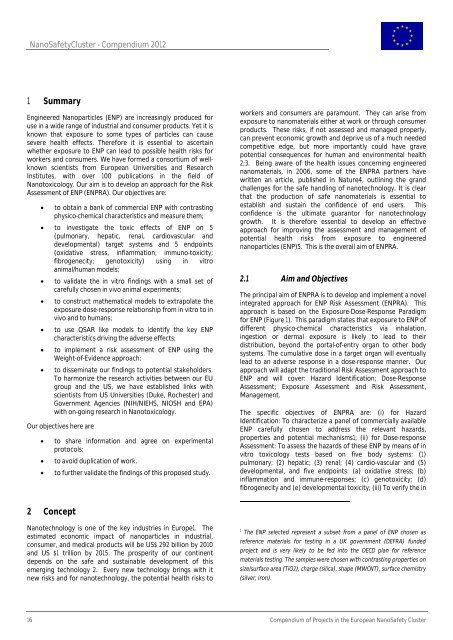Timing, hosts and locations of (grouped) events of NanoImpactNet
Timing, hosts and locations of (grouped) events of NanoImpactNet
Timing, hosts and locations of (grouped) events of NanoImpactNet
Create successful ePaper yourself
Turn your PDF publications into a flip-book with our unique Google optimized e-Paper software.
NanoSafetyCluster - Compendium 2012<br />
1 Summary<br />
Engineered Nanoparticles (ENP) are increasingly produced for<br />
use in a wide range <strong>of</strong> industrial <strong>and</strong> consumer products. Yet it is<br />
known that exposure to some types <strong>of</strong> particles can cause<br />
severe health effects. Therefore it is essential to ascertain<br />
whether exposure to ENP can lead to possible health risks for<br />
workers <strong>and</strong> consumers. We have formed a consortium <strong>of</strong> wellknown<br />
scientists from European Universities <strong>and</strong> Research<br />
Institutes, with over 100 publications in the field <strong>of</strong><br />
Nanotoxicology. Our aim is to develop an approach for the Risk<br />
Assessment <strong>of</strong> ENP (ENPRA). Our objectives are:<br />
• to obtain a bank <strong>of</strong> commercial ENP with contrasting<br />
physico-chemical characteristics <strong>and</strong> measure them;<br />
• to investigate the toxic effects <strong>of</strong> ENP on 5<br />
(pulmonary, hepatic, renal, cardiovascular <strong>and</strong><br />
developmental) target systems <strong>and</strong> 5 endpoints<br />
(oxidative stress, inflammation; immuno-toxicity;<br />
fibrogenecity; genotoxicity) using in vitro<br />
•<br />
animal/human models;<br />
to validate the in vitro findings with a small set <strong>of</strong><br />
carefully chosen in vivo animal experiments;<br />
• to construct mathematical models to extrapolate the<br />
exposure-dose-response relationship from in vitro to in<br />
vivo <strong>and</strong> to humans;<br />
• to use QSAR like models to identify the key ENP<br />
characteristics driving the adverse effects;<br />
• to implement a risk assessment <strong>of</strong> ENP using the<br />
Weight-<strong>of</strong>-Evidence approach;<br />
• to disseminate our findings to potential stakeholders.<br />
To harmonize the research activities between our EU<br />
group <strong>and</strong> the US, we have established links with<br />
scientists from US Universities (Duke, Rochester) <strong>and</strong><br />
Government Agencies (NIH/NIEHS, NIOSH <strong>and</strong> EPA)<br />
with on-going research in Nanotoxicology.<br />
Our objectives here are<br />
• to share information <strong>and</strong> agree on experimental<br />
protocols;<br />
• to avoid duplication <strong>of</strong> work.<br />
• to further validate the findings <strong>of</strong> this proposed study.<br />
2 Concept<br />
Nanotechnology is one <strong>of</strong> the key industries in Europe1. The<br />
estimated economic impact <strong>of</strong> nanoparticles in industrial,<br />
consumer, <strong>and</strong> medical products will be US$ 292 billion by 2010<br />
<strong>and</strong> US $1 trillion by 2015. The prosperity <strong>of</strong> our continent<br />
depends on the safe <strong>and</strong> sustainable development <strong>of</strong> this<br />
emerging technology 2. Every new technology brings with it<br />
new risks <strong>and</strong> for nanotechnology, the potential health risks to<br />
workers <strong>and</strong> consumers are paramount. They can arise from<br />
exposure to nanomaterials either at work or through consumer<br />
products. These risks, if not assessed <strong>and</strong> managed properly,<br />
can prevent economic growth <strong>and</strong> deprive us <strong>of</strong> a much needed<br />
competitive edge, but more importantly could have grave<br />
potential consequences for human <strong>and</strong> environmental health<br />
2;3. Being aware <strong>of</strong> the health issues concerning engineered<br />
nanomaterials, in 2006, some <strong>of</strong> the ENPRA partners have<br />
written an article, published in Nature4, outlining the gr<strong>and</strong><br />
challenges for the safe h<strong>and</strong>ling <strong>of</strong> nanotechnology. It is clear<br />
that the production <strong>of</strong> safe nanomaterials is essential to<br />
establish <strong>and</strong> sustain the confidence <strong>of</strong> end users. This<br />
confidence is the ultimate guarantor for nanotechnology<br />
growth. It is therefore essential to develop an effective<br />
approach for improving the assessment <strong>and</strong> management <strong>of</strong><br />
potential health risks from exposure to engineered<br />
nanoparticles (ENP)5. This is the overall aim <strong>of</strong> ENPRA.<br />
2.1 Aim <strong>and</strong> Objectives<br />
The principal aim <strong>of</strong> ENPRA is to develop <strong>and</strong> implement a novel<br />
integrated approach for ENP Risk Assessment (ENPRA). This<br />
approach is based on the Exposure-Dose-Response Paradigm<br />
for ENP (Figure 1). This paradigm states that exposure to ENP <strong>of</strong><br />
different physico-chemical characteristics via inhalation,<br />
ingestion or dermal exposure is likely to lead to their<br />
distribution, beyond the portal-<strong>of</strong>-entry organ to other body<br />
systems. The cumulative dose in a target organ will eventually<br />
lead to an adverse response in a dose-response manner. Our<br />
approach will adapt the traditional Risk Assessment approach to<br />
ENP <strong>and</strong> will cover: Hazard Identification; Dose-Response<br />
Assessment; Exposure Assessment <strong>and</strong> Risk Assessment,<br />
Management.<br />
The specific objectives <strong>of</strong> ENPRA are: (i) for Hazard<br />
Identification: To characterize a panel <strong>of</strong> commercially available<br />
ENP carefully chosen to address the relevant hazards,<br />
properties <strong>and</strong> potential mechanisms1; (ii) for Dose-response<br />
Assessment: To assess the hazards <strong>of</strong> these ENP by means <strong>of</strong> in<br />
vitro toxicology tests based on five body systems: (1)<br />
pulmonary; (2) hepatic; (3) renal; (4) cardio-vascular <strong>and</strong> (5)<br />
developmental, <strong>and</strong> five endpoints: (a) oxidative stress; (b)<br />
inflammation <strong>and</strong> immune-responses; (c) genotoxicity; (d)<br />
fibrogenecity <strong>and</strong> (e) developmental toxicity; (iii) To verify the in<br />
1<br />
The ENP selected represent a subset from a panel <strong>of</strong> ENP chosen as<br />
reference materials for testing in a UK government (DEFRA) funded<br />
project <strong>and</strong> is very likely to be fed into the OECD plan for reference<br />
materials testing. The samples were chosen with contrasting properties on<br />
size/surface area (TiO2), charge (silica), shape (MWCNT), surface chemistry<br />
(silver, iron).<br />
16 Compendium <strong>of</strong> Projects in the European NanoSafety Cluster






